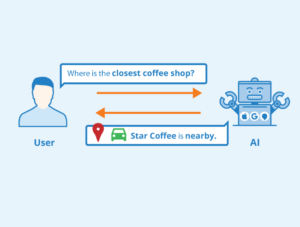Metaverse: Meaning, Examples, Top Projects & More

The Metaverse is a conceptual extension of the Internet that does not fully exist yet. The many different, currently accessible parts of it, however, promise a more immersive computing future for the human race.
In simple terms, the Metaverse is an online world that combines virtual and augmented reality with users’ inputs to create a new type of computer interface. In other words, a new way of interacting with computers.
3D or 3-dimensional imagery is a corner concept of the Metaverse. It lets you view online services, games, and businesses in a 3-dimensional way while reducing the traditional need for keyboard and mouse controls.
As you can imagine, the Metaverse is a complex concept. So, this post takes a detailed look at the industry, to help you see where things are coming from, and where they are headed.
What is The Metaverse?
The computer interface was originally a command line, at least for digital computers. Back then, you had to know the commands to enter or you couldn’t use a computer. So, it was a machine reserved for geeks.
Decades later came the graphics interface, which used a mouse to make computing as easy as point-and-click. This made the computer more accessible, with more people owning and using them for different purposes.
Years on, and as the Internet became ever more popular, touchscreen phones came into the market and further changed the Internet drastically. You can compute on the go today, play games, browse the web, and do your work anywhere with a computer that’s small enough to fit into your pocket.
The smartphone made the current social media popularity possible because operating it is as easy as touching whatever you like.
This is the current situation of the Internet.
Now, imagine an even easier-to-use computer that is equally connected to the web, does not distract you because there is no screen to look at, and lets you do your work, play games, and socialize in a very natural way.
This is the Metaverse concept. A computer system with 3D graphics that lets you interact with friends and co-workers physically or virtually, while making it easy to switch between the two. It is a virtual world that integrates seamlessly with the physical, making lots of previously impossible things possible.
Metaverse Vs WoW Vs Second Life
Many games from World of Warcraft to Call of Duty, Starcraft, and so on already integrate vast virtual worlds often called metaverses. The social game Second Life is also a metaverse in its own right. However, none of these platforms is the Metaverse.
All those virtual worlds belong to single entities or corporations. And this makes it impossible to easily move from one to the other, meaning there is no way to go from a Call of Duty location to Second Life.
The Metaverse concept is more like the underlying Internet infrastructure, or the Internet Protocol, which defines how computers must communicate with each other to make TCP, HTTP, DNS, and IP addressing possible.
The Metaverse has to be accessible to all, and not to select corporations, states, or individuals. Its foundations must be protocols that define interactions, interoperability of apps, visual information, user input, or feedback.
Metaverse Vs Virtual Reality
Virtual reality or VR is a computer-generated 3-dimensional environment that aims to be as life-like as possible, so it can appear real to its viewer. VR applications can range from business to work and entertainment.
The standard systems for virtual reality experience are currently headsets. These integrate a high-definition monitor with speakers, and motion sensors that alter the display based on your movements.
A user can theoretically build virtual real estate in the Metaverse, decorate it with beautiful NFT artwork, and make it accessible to either everyone or to paying clientele. This user’s virtual real estate can then be experienced with virtual reality headsets by anyone.
As you can see, virtual reality and its accompanying technologies are part of the Metaverse, but they are not the only ones. And while bulky VR headsets like the Oculus Rift are the standard today, technological advancement will eventually make them obsolete.
Metaverse vs Augmented Reality
Augmented reality or AR is similar to virtual reality because they both serve computer-generated images to users. However, augmented reality differs by being super-imposed information on the physical view.
What this means is that you are seeing your physical surroundings, either with a VR headset that feeds you live video or with a smart-glass like Google Glass.
In either case, you can see whatever is in front of you, plus extra computer-generated information. And this is where the augmented-reality concept shines because you can get instant and automatic information about anything you see. So, you too can enjoy cyborg-vision like the terminator.
Now, imagine paying about $10 per month in cryptocurrency to a Metaverse service. And each time a car drives by, you automatically get its make, model, color, and maybe even its license plate. Or, how about an instant display of women’s hip to waist ratios, bra-cup sizes, and other stats? This is where AI comes in.
Fundamental Technologies For The Metaverse
You have seen that the Metaverse is not entirely new, as it is the evolution of our current Internet. This evolution and its pace, however, depend on fundamental technologies to make it a reality.
Following is a look at the important technologies that the Metaverse depends on, and what roles they play.
- Blockchain Technology – The true Metaverse is decentralized, and only Blockchain technology can guarantee such a system. Individuals and corporations may have the ability to create virtual real estate, but it is the interdependence of everyone that counts.
- Artificial Intelligence – New computing features, new services, personalized services, personalized experiences, and lots more. AI has a lot to offer.
- Cryptocurrencies – A true Metaverse depends on no one and no government. This means a method of value exchange that is independent of the state, culture, and geopolitical biases. And cryptocurrencies fit that bill.
- NFTs – While cryptocurrencies are fungible – that is, can be exchanged for one another, virtual real estate must be non-fungible. And this is where NFTs or Non-fungible Tokens come in. An NFT cannot be exchanged for another NFT and this makes it unique and a great way to own digital assets.
- Headgear – This can initially be the 3D headsets that many companies are pushing. But while they may be great for gaming and other forms of virtual entertainment, such peripheral devices will find it difficult to break into the mainstream market. In other words, better visual technology is needed.
- Broadband – Broadband is getting broader, and this is good because future applications need it.
- Better Computers – Same as with broadband, the increasing capability of computers, coupled with their diminishing physical dimensions will help in making Metaverse hardware a reality.
What Defines A Metaverse?
While the Metaverse concept is still taking shape, it would be helpful to keep some of the major features of the ideology in mind. These major features are listed below:
- Real-Time Environment – The Metaverse should be always on, whether you are connected or not.
- Interactivity – It should make it easy for users to communicate with and engage other users.
- User-Generated Content – The system should enable users to build, buy, and own assets. These virtual assets can range from virtual land to houses, businesses, video, written content, images, and so on.
- Interoperability – You should be able to create one avatar and use it across all the Metaverse platforms. The same goes for payments and other valuables. Whatever you create on one platform should work on every other platform.
Top Metaverse Projects
The Metaverse is still developing, and different companies are doing it in different ways. While the future isn’t here yet, the following is a list of the most popular of these Metaverse related projects and what they offer:
- Neuralink – Implantable brain-machine interface.
- Decentraland – Buy and sell land, wearables, names, and so on.
- Highstreet – Bridges your physical and digital worlds.
- Disney’s Metaverse – In development
- Meta Hero – 3D scanning and modeling Metaverse technology
- Roblox – Online gaming platform
- Treeverse – NFT focused social Metaverse
- Magic Craft – Massively multiplayer online game
- Microsoft Mesh – Yeah, from Microsoft
- Facebook Metaverse – 3D social space
The Future with Metaverse
Though the Metaverse has not fully materialized, one thing for sure is that a standard desktop computer, a laptop, or even a smartphone will not be the ideal device to interact with it. This means the world needs Metaverse hardware that is optimized for all the features it has to offer.
How this technology will evolve and who will create the right hardware is the top question here. Virtual reality headsets are great, but a new approach is a must to reach the tipping point for the Metaverse. Apple Inc. would have been a sure bet, but Steve Jobs, the great innovator has long moved on.
Other issues to consider include property theft, Metaverse stalking, vandalism, sexual harassment such as virtual groping, and new styles of targeted and intrusive marketing.
A Word on Bionics
Apple Watch saves lives, there is no doubt about that. And is this not the greatest help that technology can render us? Of course, socializing and playing games are fun, but health, work, and family are very special.
While it is not a real bionic device, the Apple Watch is very close. Bionics is the emulation of biology using science. It is a vast field that also includes the bionic computer-mind interface that can theoretically let a user connect seamlessly to the Internet.
Consider for an instance that Musk’s Neuralink becomes a success and the chip can connect you wirelessly to the Internet via your smartphone. Also imagine an integrated augmented reality chip that gives you cyborg-like vision, loading data based on what you see or think.
The software that will manage such a system inside your head is the true Metaverse OS. And it is only possible as a bionic system.
Conclusion
Reaching the end of this exploration of the Metaverse, you have seen the technologies and the companies building them. As well as the possibilities and what the future might bring.
How things develop from here is anyone’s guess. But we may just be on the verge of another technological breakthrough.





